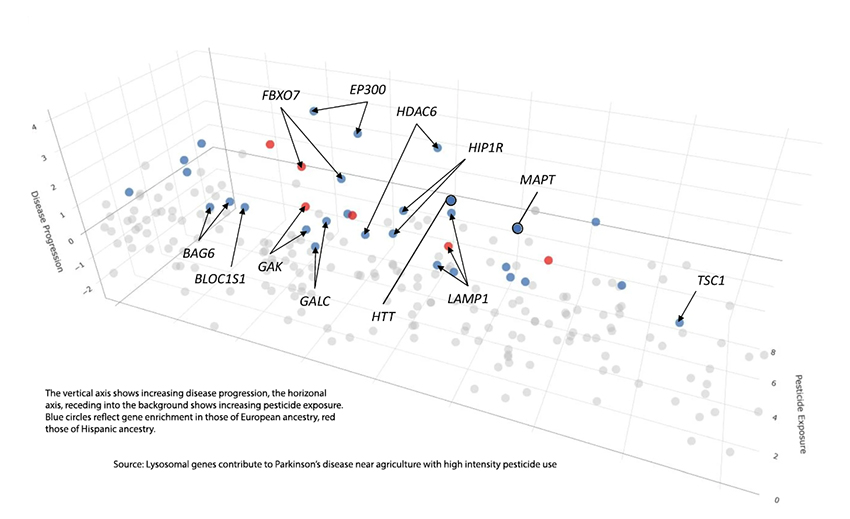Parkinson’s Disease
Parkinson’s Disease (PD) is the second most common neurodegenerative disease after Alzheimer’s disease, impacting roughly 1 million Americans. With age being a significant risk factor, that prevalence is expected to increase. PD has a plethora of symptoms – motor dysfunctions of stiffness, resting tremors, slowness, changes in mood, memory, thinking, and altering your ability to eat and sleep.
The underlying cause of PD’s uncontrolled or unintended movements is when brain cells stop producing dopamine — the why of this loss of function is a tangle of genetics, environmental factors, and aging. You can find more about Parkinson’s disease and the newest diagnostic tool for treating a disease without a specific, easily obtained marker here and here.
Alpha-synuclein is a protein involved in the movement and release of neurotransmitters, altering the transmission of our nervous system’s chemical impulses. The accumulation of misfolded alpha-synuclein is a pathologic hallmark of PD. [1]
Typically, our cells have ways to take out the trash, removing misfolded proteins, among other things. A key player in waste management are lysosomes, an organelle within our cells that removes these wastes by engulfing and “digesting” them enzymatically (microautophagy). Another lysosome-mediated waste management process, chaperone-mediated autophagy (CMA), transports the damaged material directly into the lysosome, skipping the engulfing step. [2] It makes sense to consider whether some problem in the lysosomal waste management system plays a role in PD.
“Thousands of people who allege they developed Parkinson’s because of long-term chronic effects of paraquat exposure are now suing …[and] companies deny any liability and maintain that scientific evidence does not support a causal link between paraquat and Parkinson’s disease.”
Courts have a tough time with nuance, especially something as complex as the epidemiological findings of pesticide use and the subsequent development, years later, of a neurological disorder like PD. Plaintiff’s lawyers argue the evidence is strong enough to find companies liable; defendant's lawyers argue that correlation is not causation. To be truthful, ACSH’s authors have argued that the data is unclear, often siding with the defense.
What if both sides are wrong?
Could Parkinson’s Disease develop in some individuals exposed to pesticides who have an underlying genetic susceptibility not shared with others? A study in Nature considers that possibility when looking at the genetics of lysosomes, or as the researchers write:
“The goal of this study was to assess whether exonic variants in genes known to be involved in lysosomal function are enriched in PD patients with this cotton cluster pesticide exposure.”
The researchers are looking for an effect in a small group of people, those with PD and a documented history of pesticide exposure.
“To identify genetic variation in PD patients that correlated with the magnitude of pesticide exposure, we focused on those patients with the highest exposures and the most progressive disease.”
In searching the haystack for the needle, it is not unreasonable to reduce the size of the haystack by identifying the most likely pesticides and amplifying the needle by choosing those with the most severe symptoms and exposures. This means we are considering an enrichment study.
- The patients came from an ongoing Parkinson’s, Environment, and Genes (PEG) study involving patients with confirmed idiopathic PD, its most frequent form. All had worked in California’s Central region, which supplies roughly 25% of our agricultural output. The 757 patients are more frequently male (62%), age at diagnosis on average 67 and 75% are of European ancestry, 25% Hispanic. The control group was a similar self-identified population without PD.
- Using data from the Pesticide Use Report, which includes the type and amount of pesticide used at specific sites, the researchers correlated this "dosage" with the residential and work addresses of the patients “within a 500-meter buffer of each address” to determine "exposure." Of the 68 pesticides most strongly associated with PD in this cohort, they settled on 10 commonly applied to cotton crops, the “cotton cluster,” for further stratification. In addition to epidemiological evidence, these pesticides, in combination, had been shown to be toxic to dopaminergic neurons and “previously linked” to PD.
- Disease progression was measured from patient clinical data across both the initial and subsequent follow-up visits.
- 85 genes associated with lysosomal function were studied and broken into groups “designed to prioritize genes with the highest likelihood of influencing PD risk.” [3]
With the enrichment completed, there were 386 individuals undergoing genetic analysis.
Results

The researchers identified variants of these genes among the patients based on the severity of exposure and disease. Out of the 36 prioritized variants, 72% were associated with lysosomal function
- 11% were most strictly related to lysosomal function
- 8% had lysosomal function genes already associated with PD risk
- 28%, the majority were genes with protein-protein interactions with known PD genes
- 25% demonstrated “high expression in the substantia nigra”
- 86% were considered highly harmful [4]
The number of genes at variance differed between individuals and the two ethnicities. There was no single “smoking gun” gene or gene pattern, but there clearly were enrichments in deleterious variants compared to a control population without PD.
“Association between pesticide exposure and disease progression is supported by the observation that 12 genes (12/26, 46%) had either multiple variants or variants present in multiple individuals in the PEG cohort … The impact of these variants on function is likely also important as 31 variants (31/36, 86%) were deemed deleterious or …highly deleterious …”
The researchers go on to say that
“The specific role of the identified variants in modulating PD risk and disease progression in the setting of pesticide exposure is unknown but it is reasonable to assume that it may involve impairment of protein function and disruption of specific lysosomal pathways.”
This study points to not just the dose and exposure linking pesticides to PD but to an underlying genetic susceptibility. Moreover, the work highlights the role of an indirect genetic impact, not necessarily through genes involved in dopaminergic pathways but in the more general role played by lysosomes in waste management. The debate surrounding the causal link between pesticides and Parkinson's disease will continue; however, this research underscores the importance of considering both genetic and environmental factors in this complex neurological disorder.
[1] Misfolded proteins, prions are responsible for rare infectious diseases in humans, like Creutzfeldt-Jakob disease and a recent disease in deer.
[2] There is a third waste management system, the ubiquitin-proteasome system (UPS), that tags the waste with ubiquitin, which then allows proteases (enzymes) of the “proteasome” to break the materials down.
[3]
- Group 1: All known PD risk-associated genes identified from existing literature
- Group 2: Genes involved in lysosomal function identified through a strict keyword search.
- Group 3: Genes involved in lysosomal function with known protein-protein interactions with four well-established PD risk genes - hypothesizing that mutations in these genes might impact pathways relevant to PD risk.
- Group 4: Genes involved in lysosomal function, highly expressed in the substantia nigra, a region central to PD pathology - a potential contribution to PD risk.
- Group 5: Additional lysosomal function genes associated with PD risk identified during the project’s course from relevant literature were included.
[4] The researchers assessed the “deleterious” effect using a Combined Annotation Dependent Depletion (CADD) model that integrates multiple genomic features into a single score for each variant. A score of 10 reflects the 10% most deleterious substitution in the human genome, seen in 31% of the 36. A score of 20 reflects the top 1% most deleterious, seen in 56% of those lysosome-identified variants.
Source: Lysosomal genes contribute to Parkinson’s disease near agriculture with high intensity pesticide use Nature DOI: 10.1038/s41531-024-00703-4




